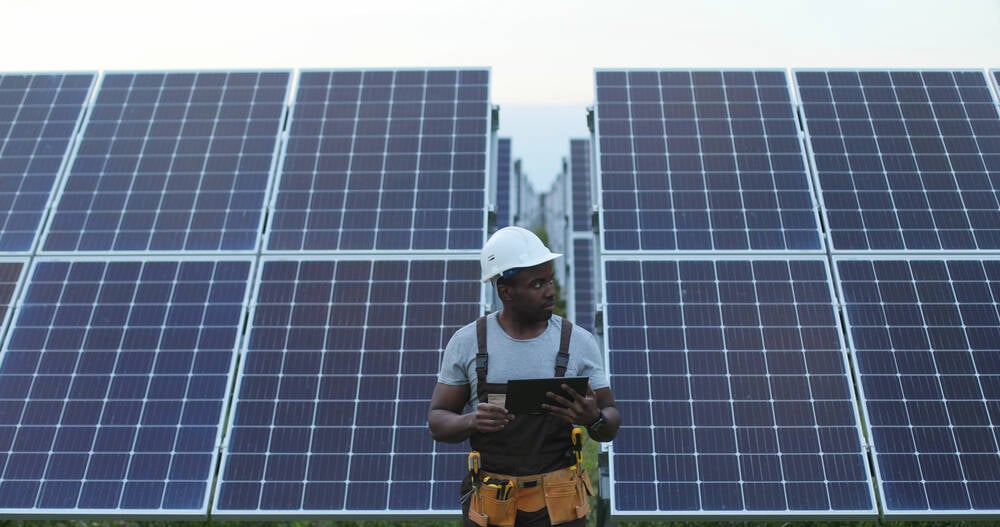Have We Hit A Climate Tipping Point? Green Power Attracts Big Money

The world has reached a major tipping point in the transition from fossil fuels to low-carbon energy: 2022 was the first year global investments in low-carbon technologies matched spending on the fossil fuel industry.
Or so claims BloombergNEF, whose Energy Transition Investment Trends report was released Thursday. In it, BNEF said low-carbon and fossil fuel investments each totaled $1.1 trillion in 2022.
For the low-carbon power sector, in which BNEF includes "renewable energy, energy storage, electrified transport, electrified heat, carbon capture and storage (CCS), hydrogen and sustainable materials," that $1.1 trillion is a year-over-year increase of 31 percent. That's alongside data showing that fossil fuel investments also rose in 2022, BNEF said.
According to the outfit's head of Global Analysis, Albert Cheung, those findings show that transitions to cleaner energy sources are here to stay. "Businesses continue to execute on transition plans," Cheung said.
"Investment in clean energy technologies is on the brink of overtaking fossil fuel investments, and won't look back," he added.
Where's the investment going?
BNEF said that renewable energies, which includes wind, solar and biofuels, received the most investments with $495 billion flowing into related projects. Electrified transportation investments, which includes vehicle spending and new infrastructure, grew by 54 percent last year and nearly matched investments in renewables, BNEF said.
On the other end of the spectrum, nuclear investments remained mostly unchanged, and hydrogen received the smallest amount of cash at just $1.1 billion in investments last year – but it was the fastest growing and tripled investments from 2021.
China outspending US
As for where in the world those investments are taking place – it's primarily China, BNEF found, which invested around half of the $1.1 trillion spent around the globe on energy transitions last year. The US came a "distant second," BNEF said, noting that if the EU was considered a single bloc it would top US investments.
- Atlassian CEO's bonkers scheme to pipe electricity from Australia to Singapore collapses
- Nuclear-powered datacenter throws open doors to tenants this year
- Self-driving car computers may be 'as bad' for emissions as datacenters
- Half of environmental claims about products are full of crap, says EU
That's not all the low-carbon transition investments that BNEF tracked, either, but it separates those out into less direct investment sectors: Power grids, supply chains and manufacturing and climate-tech corporate finance. When those are lumped in, the total low-carbon energy investment rises to $1.6 trillion, BNEF found.
BNEF said $274 billion was invested in power grid improvements last year, while supply chain and manufacturing investment rose to $79 billion, again dominated by China. As for climate-tech corporate finance, which BNEF defines as "new equity financing raised by companies in the climate-tech space," that declined by 29 percent last year, largely due to market instability.
Sorry, still not good enough
Cheung said that, despite the huge increases in low-carbon energy investments last year, "much more investment is needed to get on track for net zero in the long term."
This isn't even the first year such a conclusion was suggested by BNEF's data. In last year's Power Trends Transition Report, BNEF noted that 2021 was the first year wind and solar power fulfilled 10 percent of global electricity demand, while noting that coal-fired emissions also rose to record highs in the same period.
BNEF estimates in its latest report that low-carbon investments need to immediately triple to meet 2050 net-zero CO2 goals. "the world must invest an annual average of $4.55 trillion for the remainder of this decade in order to get on track under BNEF's Net Zero Scenario," the firm said.
That matches with the UN's data, but its outlook was even bleaker. In a September report, the international governing body said the world needed to be working seven times harder to meet climate change goals to keep global warming below the 1.5°C threshold, beyond which the worst effects of climate change lie.
The International Energy Agency has also said the world isn't moving fast enough to stave off climate catastrophe, and believes the only path to net-zero carbon involves more use of nuclear energy as a stop-gap.
BNEF's numbers don't show the explosive nuclear growth the IEA hoped, and it too predicts a lot more cash – $500 billion, to be precise – would be necessary to meet 2050 targets without more nuclear investments. There may be some sign of hope on that front, though: Earlier this week the US Nuclear Regulatory Commission certified the first commercially available small modular nuclear reactor for construction in the States. ®
From Chip War To Cloud War: The Next Frontier In Global Tech Competition
The global chip war, characterized by intense competition among nations and corporations for supremacy in semiconductor ... Read more
The High Stakes Of Tech Regulation: Security Risks And Market Dynamics
The influence of tech giants in the global economy continues to grow, raising crucial questions about how to balance sec... Read more
The Tyranny Of Instagram Interiors: Why It's Time To Break Free From Algorithm-Driven Aesthetics
Instagram has become a dominant force in shaping interior design trends, offering a seemingly endless stream of inspirat... Read more
The Data Crunch In AI: Strategies For Sustainability
Exploring solutions to the imminent exhaustion of internet data for AI training.As the artificial intelligence (AI) indu... Read more
Google Abandons Four-Year Effort To Remove Cookies From Chrome Browser
After four years of dedicated effort, Google has decided to abandon its plan to remove third-party cookies from its Chro... Read more
LinkedIn Embraces AI And Gamification To Drive User Engagement And Revenue
In an effort to tackle slowing revenue growth and enhance user engagement, LinkedIn is turning to artificial intelligenc... Read more

